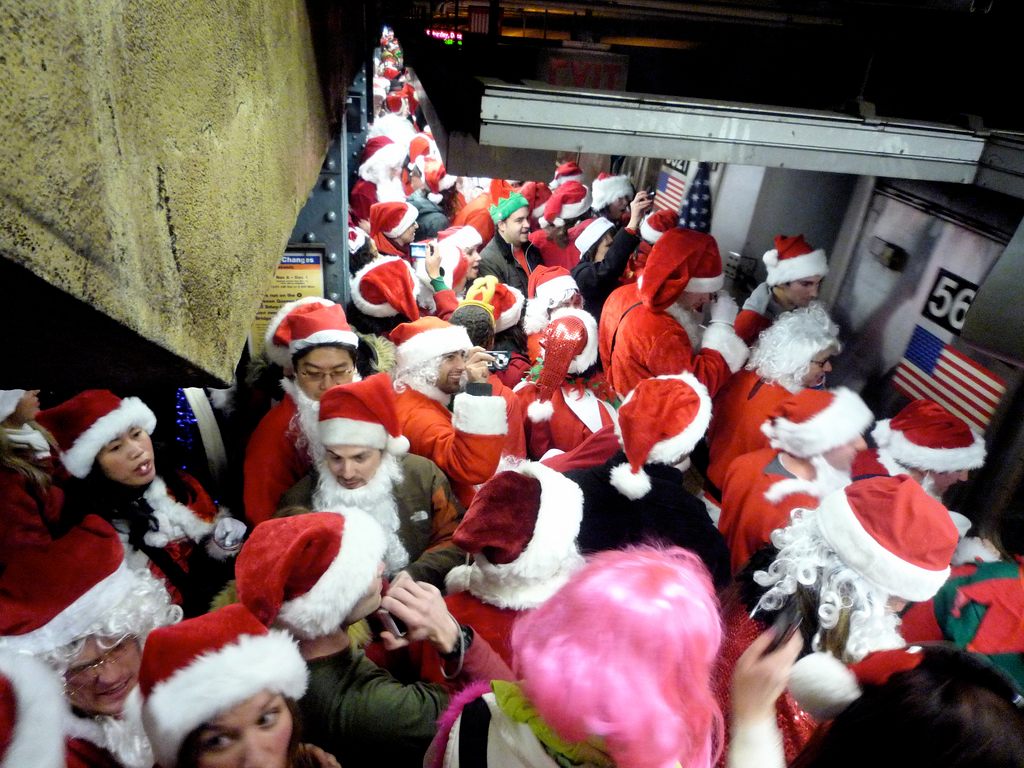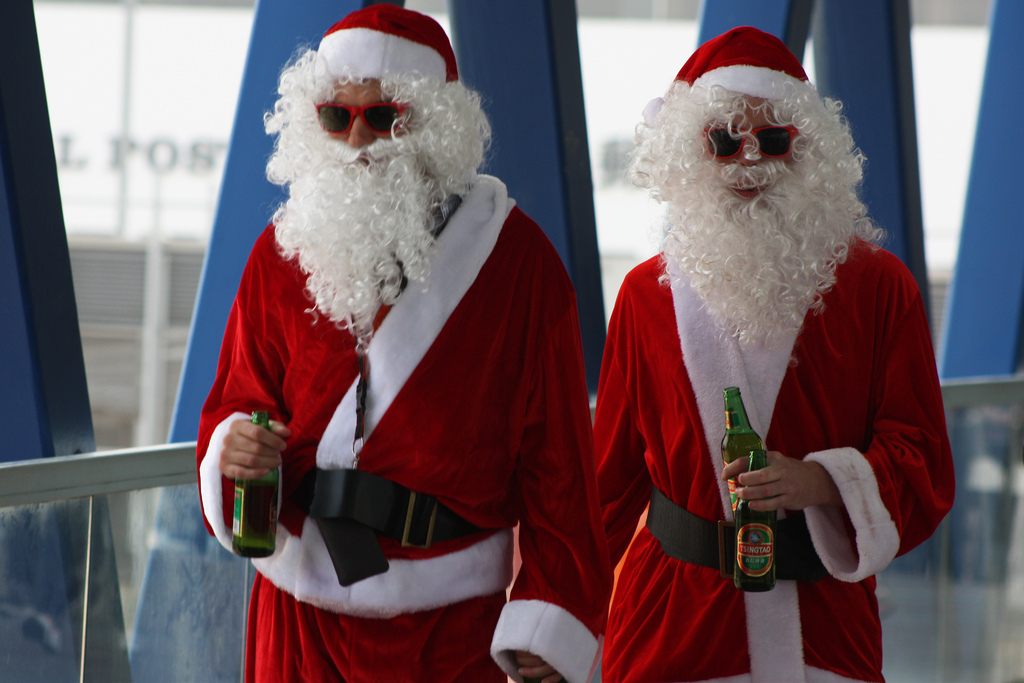The Danish Anarchists Who Inspired SantaCon Could Not Have Imagined Its Bro-Hell Future

SantaCon hits New York City’s subway. (Photo: Jason Eppink/flickr)
A sea of red and white coats rancorously swarm down thousands of streets. Hundreds of people, dressed as Santa Claus, scream and sing as they drink heavily, form impromptu dance parties, and crowd public transportation.
So goes the scene in various videos of SantaCon, a yearly world-wide celebration where anyone is welcome to dress in a Santa Claus suit en masse. Approaching the 21st anniversary of its conception in the United States, the event thrives despite controversy; in some communities and local governments there have even been battles to get the celebration banned. Participating New York City bars, readying themselves for the celebration on December 12th, may even put their licenses on the line pending SantaCon behavior.
But this event didn’t start out this way. As John Law, founding SantaCon member, told The Village Voice, it started in good “whimsical fun,” with all the trappings of ‘90s social activism. Thirty-five members of the Cacophony Society, a group of San Franciscan surrealist artists, began the parade in 1994 as a small, concerted effort to shock people at holiday parties and on the street, a sort of punch in the face to typical Christmas expectations.
Spontaneous group collaboration was encouraged as Law made speeches from a street lamp and the group posed as Santas on strike. This style of performative activism, however, soon spiraled away from its origins, and has grown to include people who seem less interested in challenging American consumerist culture. But this was far from the first time that any group thought to use Santa imagery in a provocative manner.
The original inspiration for SantaCon actually came from a 1977 article in Mother Jones about a four-day event organized by Solvognen, a socio-politically charged anarchist theater group in Denmark. Solvognen, literally “Chariot of the Sun”, took their name from Norse mythology and the name of a highly prized national artifact that represents a horse pulling the sun across the sky.
The Cacophony Society preserved the satirical aspect of the Danish production, but the stakes raised in Solvognen’s performance were more serious. While Cacophony members in San Francisco admired the use of guerrilla theater tactics to point out discordant holiday expectations, they still adopted the general sentiment of Santa Claus spreading holiday cheer. The Danish group’s satire, however, was of the sort that gets participants arrested and beaten; the type that consciously rebelled against the cultural influences of consumerism, and provided the scenario that makes observers unwittingly participate as accidental actors: political theater activism that was brainstormed and planned to precision.
Solvognen’s four day “Santa’s Army” demonstration of 1974 began with what seemed to be a benign parade. Ellen Frank wrote in Mother Jones that 35 Danish men and women joyously marched down the streets of Copenhagen and “rode a large white horse”–a 30-foot tall goose that some accounts mention was tugged along and set up as a Trojan horse. The entire stunt was planned to look, for the first day, like a normal, good-natured and enthusiastic parade; Solvognen members waved Danish flags and sang carols as they gave out hot drinks to people on the street.
But the next day’s processions took a political turn: after singing carols at the police station the Santas, called “Christmasmen,” broke into a General Motors factory and made speeches about the unemployment crisis from a crane. Video footage shows joyful Santas holding rakes and sickles, attacking the walls of Copenhagen’s Labor Court. The event slowly transformed from what seemed like a random, innocent celebration to full-on social upheaval.
The core of the demonstration hit on the fourth day: Christmasmen sneaked into Magasin, a major department store, changed into their Santa gear and began to invite customers to take books on the store shelves, smiling and hugging patrons while telling them that in the holiday spirit, everything was free. People laughed in gleeful celebration and surprise. Police arrived to stop the guerrilla performance, arresting the Christmasmen and beating them in the street while children cried and some adults tried to get the police to stop. As Brett Bloom writes in Realizing the Impossible: Art Against Authority, a photograph of police officers beating one Santa was published in every Danish newspaper of the time. This media attention gave Solvognen members a loud voice, and possibly more social impact than the demonstrations themselves.

Santas on New York’s streets as part of the 2014 SantaCon. (Photo: Anthony Quintano/flickr)
Any quote from the Solvognen group includes the importance of their message. In Mother Jones, a group member told Frank that they wanted “to make demonstrations more fun and for the people” and that they “showed the cultural significance of crime.” One Danish documentary quotes the group stating that the Santa Army was a comment on the “bourgeoisie terror on Christmas and unemployment in the wake of the oil crisis.”
Solvognen even published a book, When Santa Claus Came to Town with Solvognen, which provides a partially fictional backstory and account of their actions: Santas were invited to visit Copenhagen from the North Pole, only to find that the city was suffering from rampant poverty. The children’s book-style prose and real photographs echo the event; innocent Santas romp around town, planning to help the community by re-opening a factory themselves, which of course is not allowed. The Santas in this story speak with the factory manager after breaking in:
‘How can you throw all the workers out just because you aren’t earning enough money?”
“This doesn’t concern you, Mr. Santa Claus. This is undemocratic, I’ll have you know.”
The manager was so nervous he was shaking.”’
In less Christmas-y parts of the year, Solvognen made a frequent point to voice social concerns. Many of the group’s members lived in and helped form an anarchist-based commune at an abandoned military base in Copenhagen called Christiania, which has thrived for over 40 years in defiance of conventional law. Influenced by the Danish Youth Rebellion of 1968 and widespread Situationist, Surrealist, Anarchist and Dadaist movements, Solvognen performers wanted to confront the public and rebel against upper-class exploitation and control.

The end of the night for San Francisco’s SantaCon, or possibly the beginning. (Photo: Christine Puccio/flickr)
In the 1960s, other anarchist groups had similar social demonstrations in major cities. A member of London-based anarchist group King Mob dressed as Santa and gave store toys away at Selfridge’s department store (which led to arrest). The New York Dadaist art group Black Mask, who inspired King Mob, similarly gave out toys from Macy’s by posing as employees, who moved stock to irregular locations and set dogs and cats free in the store. Bloom notes that former member Nina Rasmussen was certain Solvognen was not influenced by these groups, but they did share a common ability to transcend location through media and word of mouth. In the aforementioned documentary about Solvognen, Rasmussen says, “We wanted a public debate, we had no power, but wanted some kind of influence–by starting a discussion, and I think we managed to do that.”
Today Solvognen’s activism has seen a light resurgence under the name Trundholm Bog, a reference to where the Sun Chariot artifact was found. In 2006 Trundholm Bog Members wore prison-orange jumpsuits and black hoods, and marched in a grim parade in honor of prisoners held at the U.S.’s controversial Guantanamo Bay detention camp. In a somewhat ironic development, in 2005 the group was canonized by the Danish Ministry of Culture, and as Majken Jul Sørensen writes in Humorous Political Stunts, the Santa Army performance is “considered one of 108 cultural expressions that is part of the Danish cultural heritage.”
Unlike Solvognen’s demonstration, SantaCon was supposed to be more playful: less planned, and full of collective, spontaneous ideas. Also different was that in the U.S. at least, the event was repeated. (Solvognen participants had a much different attitude toward their performances, and told Mother Jones, “We have one rule–never do anything twice.”) The second year of SantaCon brought 100 people, the next event over 200 participants. As the popularity of SantaCon exploded, it shed its original ideological meaning.

Hong Kong’s SantaCon. (Photo: istolethetv/flickr)
In fact, today SantaCon removes itself from any of the traditional Christmas traits of generosity or good will that Solvognen referenced. One official website reminds everyone to wear red, have fun, not terrorize the public, and abuse anyone dressed as an elf. The rules are supposed to be as playful as the event; but the participants are given license to decide which rules are serious and which are not. Rules that may or may not be taken seriously state: “Don’t get drunk” (there are now four references to drinking on the website), don’t talk to the press, and remember that groups of Santas can do more “or get away with” more than a single Santa alone.
Without the usual context of gift-giving and commercialization, it’s challenging to make any sort of serious point, not to mention the difficulty posed when focusing large, anonymous groups on a single ideological task. SantaCon morphed from something pointedly anti-establishment to more of an open free-for all, possibly aiding the exportation of consumerism its origins fought against.
Some might argue that this simpler version is the only sort that could carry on and grow from year to year as it has; a more difficult argument to make would be that it might ever go away. Whatever the original meaning or message, the celebration will roar in nearly every U.S. state and in many countries around the world (SantaCon claims 355 cities and 49 countries) this month, with more roving Santas likely to join the party next year.










Follow us on Twitter to get the latest on the world's hidden wonders.
Like us on Facebook to get the latest on the world's hidden wonders.
Follow us on Twitter Like us on Facebook